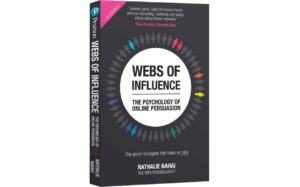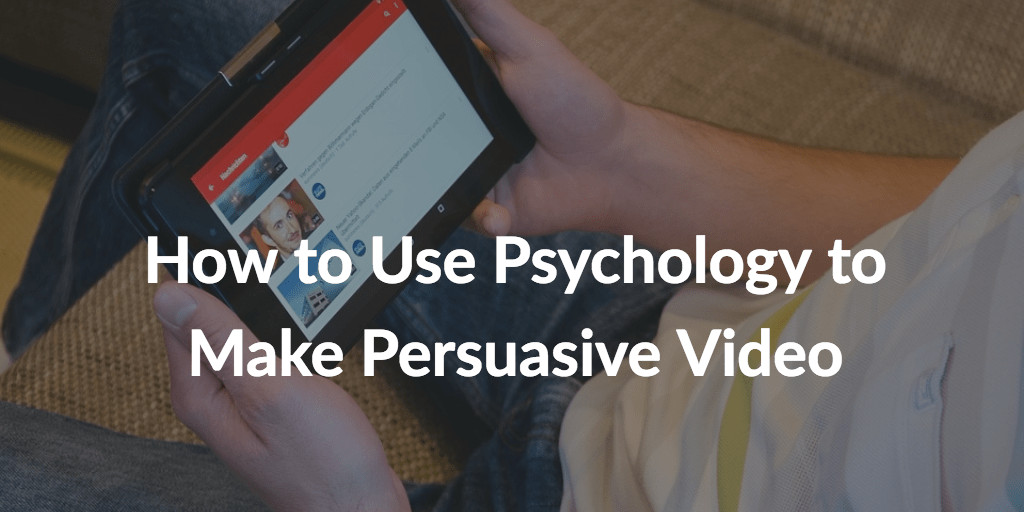Nir’s Note: This guest post is excerpted from Nathalie Nahai’s best-selling book, Webs Of Influence: The Psychology of Online Persuasion.
A film, a piece of theatre, a piece of music, or a book can make a difference. It can change the world. – Alan Rickman, Actor
What Makes Video Special?
Compared to other media types on the web, video is unique in the immediacy with which it can convey a vast amount of emotional and informational content to its viewers. By virtue of the fact that video is an instantaneous form of communication, it has the advantage of being able to create a shared experience, in which people can watch the same thing at the same time, wherever in the world they might be. As with all social content, enabling people to participate in such a way can create a profound sense of connection and community, which can help generate word of mouth and amplify the reach of your message.
Unlike images or copy, video (and audio) set the pace at which a story or message is delivered. Although it is true that people can stop watching whenever they choose, the analytics tools built into video hosting platforms are making it easier than ever before to assess when people are bouncing away. This means that you can track exactly how far individuals get through a piece of content before they stop consuming it, which may help infer why the video isn’t engaging its viewers as expected. This can then inform the process by which you optimise your media, making video one of the most trackable forms of web content, as well as one of the most emotive.
When used onsite, videos can also help boost conversion rates, both in general and when used to showcase specific products or services. A private study exploring customer behaviors on electrical goods website ao.com, found that those who watched a product video were 100 per cent more likely to convert, spending an average of 9.1 per cent more than those who didn’t. In another study, customers who watched videos (of all kinds, not just those of products) on wistia.com were found to be 63 percent more likely on average to convert.
Why We Watch
From a psychological standpoint, there are various reasons why we watch videos. The first, while it may not sound particularly scientific, is just because. The internet is replete with bizarre videos that go viral for no apparent reason (remember Damn, Daniel?), and in such cases the magic dust that contributes to their success is ephemeral, hard to articulate and therefore rarely replicable after the fact.
Perhaps more tangibly, we also watch videos because they provoke curiosity by providing a pattern interrupt, a sequence or narrative in which our expectations are flouted. A great example of this is Geico’s 15-second Going Up: Fast Forward advert, a pre-roll ad on YouTube that starts in an elevator, in which a woman is telling her friend how switching to Geico saved her money on her car insurance, while a bald man with a comb-over watches on. Before we can see any more, the video cuts short as an image fills the screen displaying the message, ‘Geico. We now fast forward to the end of this ad’ with an accompanying voiceover. We rejoin the video a few seconds later to find all three are now bald, as the women scurry out of the lift complaining ‘Next time, let’s take the stairs’. The video ends with a link inviting people to ‘Click to see what happened’, and I won’t spoil the surprise by giving the end away here.
The reason this is compelling is because it disrupts our expectations around the format and content of a pre-roll ad, which we have come to expect to be linear in narrative, last 30 seconds, and be salesy and self-serving in tone. By challenging our assumptions and provoking an emotional response, our attention is piqued and we feel the pull to actively attend to the message.
This leads us to the very heart of why we watch videos – we engage with content to change our emotional state. Because video includes so many of the real-life cues we rely on to communicate with and understand one another (from facial expressions and gestures, to linguistic content and tone of voice) it is one of the most effective content types for transmitting emotional contagion. This is a phenomenon which can be leveraged at both ends of the emotional spectrum, from the delightfully cute to the painfully sad, and we need only witness the ubiquity of cat videos to see this in action. Believe it or not, scientists have actually conducted research to examine why we spend so much time watching videos of our feline friends. As it turns out, even a short clip can be enough deliver an emotional payoff, with participants reporting that they felt more energetic and positive (and less anxious, annoyed or sad) after only a few minutes spent watching cats.
Persuasive Storytelling
While we tend to enjoy and share content that has a positive emotional valence, videos that move us towards sadness and anger can also be persuasive and powerful. A great example of this is one of Amnesty’s video campaigns, contrasting the morning ritual of a girl living in Australia, to that of her counterpart living in war-torn Syria. By presenting the narrative as a split-screen story, the left side of the screen showing the young Australian, and the right, the Syrian, Amnesty communicates not only the nominal similarities of each situation, but also the contrasting realities confronting each child.
The reason stories such as these are so compelling can be found at neurological and psychological levels. In an fMRI study conducted at Princeton University, neuroscience Professor Dr. Uri Hasson and his team set out to investigate exactly what goes on in our brains when we tell, and listen to, a story. They discovered that when two people are engaged in such an exchange, both display similar response patterns across a remarkable number of regions in the brain, an act they describe as neural coupling. Far from being a passive process, they proposed that storytelling is, in fact, an experience which, when successful, results in the teller and receiver literally getting on the same wavelength.
Achieving this, however, requires a skillful, nuanced approach. Whether you’re trying to move people to buy your product or donate towards a cause, feelings such as sympathy, sadness, and compassion have been found to play a central role in motivating us to engage with and help others. From a psychological perspective, finding a way to tell your story through the narrative of one person, as opposed to that of many, can also have a profound impact on the way in which your message is received. Charities have long known the effectiveness of this approach, and subsequent research supports their strategy.
Given that our attention actually magnifies our response to emotionally charged situations, and that the larger the group, the more our attention and ability to focus diminishes, it makes sense that a story would be most compelling when conveying the plight of a single individual. For instance, battle scenes in films tend to be most engaging when they focus on the protagonists rather than just a mass of fighting people. Since we are more likely to view a single person as a psychologically coherent unit than a group, this may explain why we tend to feel greater compassion and distress towards the former.
Described in academic literature as psychophysical numbing, it is this phenomenon that is thought to be at the root of many behavioral asymmetries we see today. The discrepancy in emotional reaction towards minor stories (such as the plight of Pale Male, a hawk evicted from his nest in Manhattan), compared to those of much greater magnitude (the desperate condition of two million homeless Sudanese), points towards a profound difference in the ways we process events. That’s why, if you’re trying to engage your audience with videos that compel them to take an action, focusing on a specific, emotional, discrete story around one individual will tend to be more effective than speaking about an abstract, homogenous group.
If you’re looking for even more research on this topic, then I invite you to download my 18-lesson PDF course on Product Psychology. I’ve asked the brightest minds in the field to share their best resources on user behavior:
Emotion And Arousal
Whether the stories we tell are large or small, complex or simple, they all serve to take us on a journey from one emotional state to another, often with many transitions in between. Depending on the length and purpose of your video, and the profile of the audience for whom it has been created, there are various different models you can use to help structure your narrative. A good place to start is by reading The Hero with a Thousand Faces, a seminal book that explores the journey of the archetypal hero, written by American mythologist Joseph Campbell.
Used the world over to craft compelling tales, one of Campbell’s most famous narrative arcs is The Hero’s Journey, a 12-step sequence that appears in everything from drama and myth, to religious ritual and psychological development. This pattern has been used in many of the stories we know and love today, and was even acknowledged by George Lucas for its influence on the Star Wars films.
Whether you’re using The Hero’s Journey or another of Campbell’s models, two adverts that are worth watching for their use of this approach are John Lewis’ Christmas advert, The Journey (2012), and MetLife’s insurance advert My Dad’s Story: Dream for My Child (2015). Both videos carefully orchestrate the ebb and flow of emotion to hold the viewer’s attention until the very end, at which point they leave the audience with a heightened, positive emotional climax. The importance of a powerful ending cannot be overstated, and in behavioural economic circles, there is even a phrase used to describe this heuristic. Known as the peak end rule, this term refers to our tendency to judge experiences based on how we feel at their peak (their most intense points) and at their end, rather than taking an average or sum of every moment. If you want to create persuasive videos, you can leverage this dynamic to craft emotional highs and lows.
Music can also elicit such responses, from boosting our motivation, feelings of pleasure, and relaxation, to reducing levels of pain and anxiety. Music can even increase or decrease our breathing and heart rate, depending on how upbeat or meditative the tempo, respectively. This is why, when choosing the score for your video, you should ensure that it elicits the level of arousal that matches both your content and the call to action.
Not only is music influential in grabbing people’s attention, if you’re narrating an advert or piece of video content, research has found that lowering the pitch of your voice can signal status, which can be perceived by others as dominant, prestigious and admirable, traits positively correlated with behavioral influence. However, when a person’s voice goes down in pitch, they can also be judged as wanting to be more intimidating and domineering, so it’s a balance that must be struck with care. Of course, if you’re working with video, you can also make use of non-verbal cues such as body language, gestures, and clothing, so as to mirror your audience’s preferences and expectations (for a great example of this, check out Burger King’s anti pre-roll ads).
Making This Work For You
Videos by platform:
– Facebook, Instagram, Twitter – All of these platforms enable auto-playing videos, which means that to get the best response, your content has to be visually compelling even without any sound (emotive visuals and/or the use of captions can work well here). As these channels are primarily accessed through mobile devices, your video format can be vertical. Since browsing behaviors will typically be in feed, whatever the content of your video, it has to be visually attention-grabbing within the first few seconds in order to capture the fleeting attention of fast scrollers.
– YouTube – Despite its reputation as the primary video hosting platform, YouTube’s most popular content has historically been music. In terms of branded ads, those that are most successful tend to be videos that disrupt our expectations, change our emotional state, and make us laugh (such as the Geico and Burger King adverts mentioned earlier).
– Vimeo – Another popular hosting platform, this channel typically attracts a smaller, more creative community, and can be a good place to share work for which you wish to receive more constructive feedback.
– Your website – The videos you create for your website will naturally be designed to achieve a different outcome than those created for your social channels. Onsite videos should be goal-oriented and work within the context of a page, never sitting in isolation. If you want to increase play rate, you should match the visual branding of your video (the thumbnail and video player) with your brand and website. The video’s prominence on the page will also impact engagement, and as a rule of thumb, the higher up the page it is, the more views it will accrue. Whatever content you create, a beautiful, purposefully designed thumbnail (especially those including human faces) will be more likely to trigger plays.
– Video hosting for business – If you’re designing videos specifically for use on your website, there are several platforms you can use that have been developed specifically for this use-case (such as Wistia, Brightcove, and Vidyard). Offering more detailed analytics, tools and functionality for personalisation than social video platforms, these services can provide a great way to manage your content and gather vital data that can help you optimize your approach.
Nir’s Note: This guest post is by Nathalie Nahai, the best-selling author of Webs Of Influence: The Psychology of Online Persuasion. The expanded 2nd Edition of her book is available now.
Related Articles
- Schedule Maker: a Google Sheet to Plan Your Week
- Cancel the New York Times? Good Luck Battling “Dark Patterns”
- How to Start a Career in Behavioral Design
- A Free Course on User Behavior
- User Investment: Make Your Users Do the Work
- Variable Rewards: Want To Hook Users? Drive Them Crazy
- The Hooked Model: How to Manufacture Desire in 4 Steps

